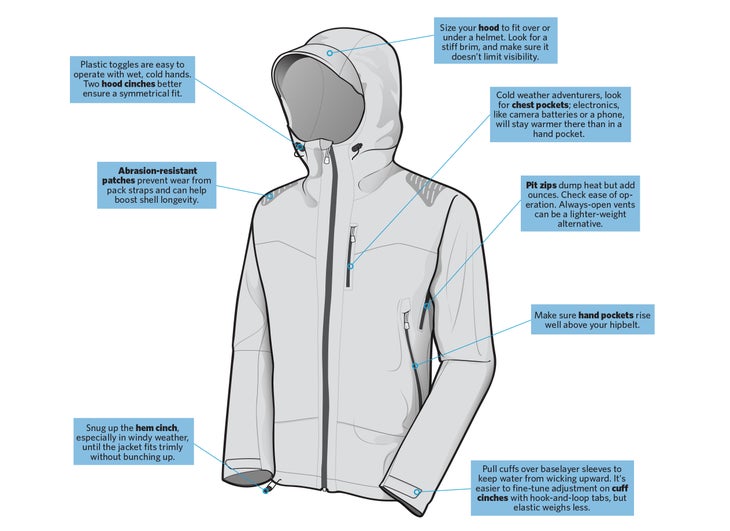Heading out the door? Read this article on the new Outside+ app available now on iOS devices for members! Download the app.
The Shell Expert
Ouray Mountain Sports has long been a go-to for mountaineers, and that tradition continues under Bill Leo, who bought the shop 22 years ago. “The thing that’s special about us is the knowledge of our staff,” Leo says. “That’s how we’re able to cater to high-end climbers, the people who are the hub of North American alpinism.”
How to Buy a Shell: Ask the Right Questions
Does it fit? Make sure you can reach over your head and cross your arms without restriction—the work of scrambling, throwing bear bags, and pitching tents needs to be done rain or shine. Winter camping? Make sure layers (including gloves) fit under your shell. Warm or windy weather? A slimmer cut offers better breathability and less flapping.
How well does it vent? Most shells struggle to deliver on the “breathable” promise. The problem is exacerbated with budget shells, so look for ventilation features like pit zips and long, mesh-lined pockets.
How packable is it? Heavy-duty, feature-rich shells tend to take up more pack space, while water-resistant wind jackets and lighter shells often zip into their own pockets for better compressibility. Hoping to leave your shell rolled away for the majority of the trip? Make sure it packs down small.
How weatherproof is it? If you’re expecting the sky to fall in, make sure your jacket’s ready for it: In all-out rain, hem and hood cinch cords, waterproof zippers (as opposed to just flaps), and cinchable cuffs can prove to be invaluable lines of defense.
Is it pack-compatible? Load up, cinch the hipbelt, and bend over. Exposed skin indicates a too-short cut. Also check whether pockets are accessible with a hipbelt on and that no toggles or hardware fall under pack straps.
Anatomy of a Shell
Learn your way around your shell. (Too small to read? Click the image to view the full-size version.)

The Rookie Mistake People Make With Shells
“The biggest mistake I see people make is either buying a waterproof shell when they don’t need one or buying a water-resistant shell when they really need waterproof,” Leo says. Softshells are breathable and stretchy, and they’re ideal for working hard in snowy conditions or for blocking light wind. Water-resistant wind jackets are ideal for dry weather. “You only need a hardshell if you’re really going to be subjected to rain,” Leo says. But then you really need one.
Shell Owner’s Manual
Avoid smoke. Smoke particles adhere to fabric and interfere with DWR. Ditch your shell before breaking out the s’mores.
Wear long sleeves. Skin oils, sunscreens, and insect repellents can damage membranes and impair breathability. Avoid wearing your shell next-to-skin whenever possible.
Store it dry. Like your tent, your raingear needs to air out between uses to avoid developing mildew, especially during long-term storage.
Basic Shell Repair
Shells come out when the hiking gets hard. As such, they suffer their share of abuse. Sam Goodhue, product developer at Boulder Mountain Repair, sees about 8,000 to 10,000 damaged shells per year. Here’s what tends to go wrong.
Waterproofing failure. Wetting out but not leaking? Clean with gear wash. Reapply DWR with a product like Nikwax TX.Direct if needed.
Torn fabric. Clean the area with an alcohol prep pad. Trim any threads and sandwich the tear between two circles of repair tape.
Peeling seam tape. For small peels, cut off loose bits and paint the exposed area with Seam Grip. Catastrophic peeling? Call in the experts.
Broken drawstring. Open the seam where the drawstring is anchored, cut out the old cord, and re-thread from there. Then, sew up the seam.
Learn the Shell Lingo
Three-layer vs. two-layer: Three-layer shells sandwich the waterproof layer between a DWR-coated face fabric and an interior liner to protect the delicate membrane. Two-layer shells (just the face material and membrane) tend to be less expensive and more packable, but less durable.
